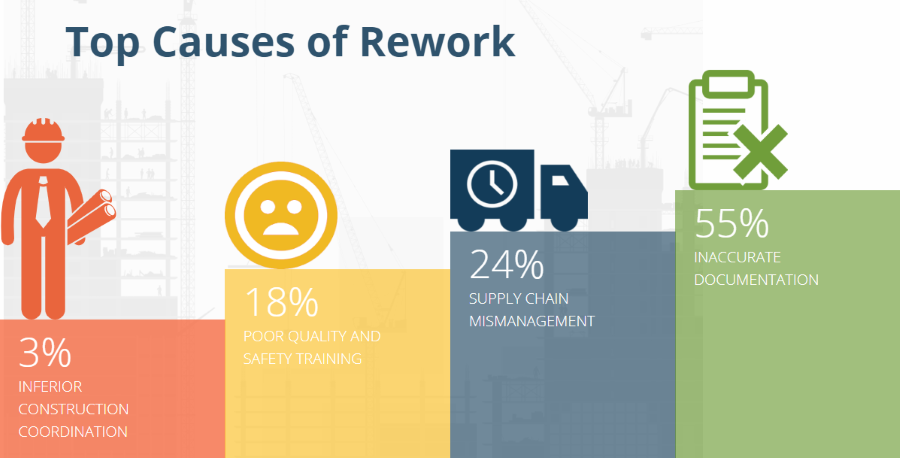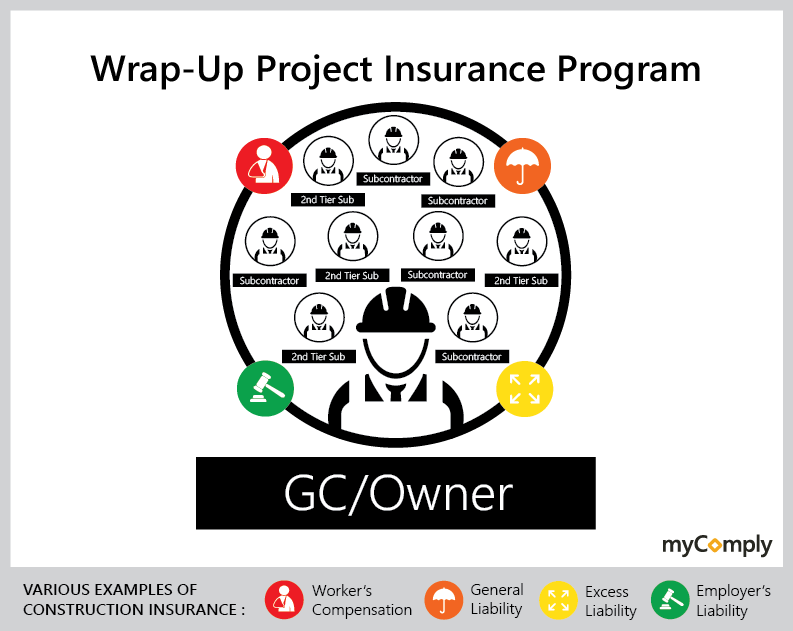The Burj Khalifa, the One World Trade Center, the Beijing Airport, California’s high-speed railway… these are a few of the greatest mega construction projects (past/present) in the world. One might think that with project costs to the tune of hundreds of millions, that these mega projects would have mega margins. However, construction profit margins are often much less than one might think.
This article explores the nuances of mega construction projects, how construction ROI is calculated, as well as four tactics that can be deployed to improve construction profit margins.
Table of Contents
What is a Mega Construction Project?
Average Construction Profit Margins
Construction Hard Costs vs Soft Costs
What is a Hard Cost?
What is a Soft Cost?
Measuring Construction ROI
4 Tactics to Increase Mega Construction Profit Margins
1. Reducing Request for Information (RFI) Costs
2. Reducing Rework
3. Building Robust Training Programs
4. Reducing Insurance Costs
Conclusion
What is a Mega Construction Project?
According to the Oxford Handbook of Megaproject Management, mega construction projects can be defined as large-scale and highly complex ventures that cost in excess of $1 billion. However, there are a number of different factors that should be used to assess whether a or not a project deserves mega construction status.
The key characteristics of mega construction projects are as follows:
- Any project that exceeds one billion in total cost can be classified as a mega project.
- Mega construction projects generally deal with more intricate architecture, engineering, and execution, which generally requires more specialized contractors.
- For example, a high-rise project in a busy urban setting caries a much greater degree of risk than a ground-level rail line. With greater risk, comes greater insurance costs, greater risk of loss, and quite often, mega-status.
- Most mega projects are designed to achieve one of two ends: utility or visibility. An airport expansion would be an example of utility. A skyline defining high-rise would be an example of visibility. Therefore, projects that influence people and culture are more likely to be deemed mega in nature.
Here are a couple of the biggest mega construction projects underway around the globe today:
The Al Maktoum International Airport Expansion in Dubai ($32 billion)
Source: Airport Technology
California’s High-Speed Railway ($100 billion)
Source: Government of California
Average Construction Profit Margins
Construction is a notoriously low-margin industry, and that’s largely due to the sheer complexity of projects. Profit margins also tend to vary greatly depending on several factors, such as supply and demand of labor, bidding accuracy, and the fluctuation in costs of input materials.
So, what is an acceptable or desirable profit margin in mega construction?
Leo Quinn, Chief Executive Officer of Balfour Beatty, has stated that margins below 5% are unsustainable. However, it is standard for GCs to realize margins as low as 1.5-2% on mega projects. In fact, a poll conducted by Building Magazine found that two-thirds of respondents did not expect to realize margins of 5% anytime in the near future.
Construction Hard Costs vs Soft Costs
General contractors and construction managers that are overseeing mega projects need to keep a mic on costs throughout the duration of a project. For most projects, these costs can be broken into two buckets: hard costs and soft costs.
What is a Hard Cost?
A construction hard cost is anything that pertains directly to the physical construction of a building. These costs are predominantly fall under the umbrellas of building materials and labor.
Here are some examples of hard costs for a general contractor or construction manager:
Subcontractor labor costs:
- Demolishing an existing structure
- Excavating
- Grading
- Electrical
- Plumbing
- HVAC
- Carpentry
- Welding
- Finishing
Material costs:
- Concrete
- Steel
- Glass
- Lighting
- Flooring
- Paint and other finishing materials
What is a Soft Cost?
In mega construction, a soft cost is anything that does not pertain directly to the physical construction of a building but is still necessary to facilitate the completion of the project. These costs are sometimes referred to as “overhead” costs and tend to include a variety of licensing, design, financing, and administrative expenses.
Here are some examples of soft costs for a general contractor or construction manager:
Services:
- Administrative
- Financial
- Project management
- Architectural
- Engineering
Permits and licenses:
- Construction insurance
- Utility permits
- Building permits
Measuring Construction ROI
Measuring or projecting mega construction ROI can prove to be a difficult calculation without the assistance of financial management software. However, these basic calculations can help you garner a quick estimate as to the ROI of your projects.
The standard ROI formula is as follows:
ROI = (Net Profit / Cost of Investment) x 100
For general contractors, net profit and cost of investment can be broken down as follows:
Net Profit = Projected Project Cost + Markup %
Cost of Investment = Hard Costs + Soft Costs
Therefore, the basic formula for construction ROI can be written as:
ROI = [(Projected Project Cost + Markup %) / (Hard Costs + Soft Costs)] x 100
4 Tactics to Increase Mega Construction Profit Margins
Whether you are concerned about diminishing profit margins on your project or are interested in driving greater project profitability, there are a number of tactics that can be deployed on your mega construction projects.
1. Reducing Request for Information (RFI) Costs
RFIs are formal requests for information regarding specifications, plans, contracts, or other key project-related documentation. These requests are generally issued in response to a change in plans, gaps/ambiguities in plans, conflicts, or a project error. The RFI seeks to resolve these gaps and mitigate the need for costly corrective measures.
In construction, RFIs are more common than a McDonald’s in Manhattan, and more costly than a Pollock painting. In fact, the average construction project generates 9.9 RFIs per one million in project work. The average cost of each of these RFIs is $1,000. That amounts to just shy of $10,000 per one million in project work, or 1% of project margin. General contractors and construction managers simply can’t afford to give up 1% of their margins.
The reality, however, is that RFIs are a necessary part of the construction process. General contractors won’t be able to eliminate RFIs completely, but there are steps that can be taken to reduce the costs associated with them.
Here’s how to reduce RFI costs on your jobsite:
- Instigate an early submission policy. Data shows that the average RFI response time is 4 days, which means that it is critical to promote early problem identification.
- Create an RFI template. This ensures that all RFIs follow a standardized format and will contain all necessary information so that swift response action can be taken.
- Digitize the information. Cloud-based construction software can make it quicker and easier to document and share RFIs with the relevant parties.
2. Reducing Rework
In construction, rework can be described as redoing or repairing any work that was not done correctly the first time. Rework is generally the result of errors during the design process, change-orders, omissions, or any other mistakes stemming from design, training, supply, or execution.
Source: Autodesk
According to a survey conducted by PlanGrid and FMI, the global construction industry spends approximately $178 billion annually on rework activities. Depending on the project, that accounts for anywhere from 2% to 20% of a project’s total contract amount.
Though errors cannot be eliminated from the jobsite, there are actions that can be taken to limit the need for rework activities on your jobsite.
Here’s how to prevent unnecessary rework:
- Foster clear and open communication. On most mega construction projects, there is an owner, general contractor, many subcontractors, field crews, delivery crews, and more. In order to mitigate the greatest rework losses, clear communications procedures must be established, and all workers should be equipped with mobile devices and project management software.
- Double-down on design. The more constructible your project is in the beginning, the less need there will be for change-orders and late-stage changes on the construction front.
- Run building information modelling (BIM) software. BIM technologies enable contractors to virtualize projects early in the construction phase. This allows contractors to determine potential conflicts before they arise, while also communicating all project changes to relevant contractors in real time. The leading BIM solutions for mega construction are Autodesk’s BIM 360 and Procore’s BIM.
myComply is a proud partner of both Procore and Autodesk. Click here to learn how you can use these solutions together to better manage your mega project from end-to-end.
Interested in reducing rework on your projects? Learn how you can apply the lean construction principles to drive process improvement on your projects.
3. Building Robust Training Programs
Mega construction projects are inherently complex and dangerous. Massive structures and large equipment are essentially prerequisites for most mega projects. That means that workers are expected to mitigate risk on a daily basis.
Some of the greatest construction site hazards include:
- Falling from heights
- Falling objects
- Motor vehicles and heavy equipment
- Working in confined spaces
- Dust inhalation
- Carrying heavy loads
- Exposure to dangerous substances
With all these safety hazards in effect every day, it is critical to have a thorough training procedure in place to mitigate as much risk of injury or death as possible on your jobsites.
Here’s how to reinforce your training programs:
- Preach a safety culture. One of the best ways to prevent accidents on your construction sites is by ensuring that safety is woven into the fabric of your culture. Orientations are critical to this effort as they are the first touchpoint between each worker and your company. Orientations are also an opportunity to showcase the various safety measures that are/will be in-place on the jobsite.
- Leverage orientation software. Site orientations are a critical component in the project training process. It’s important that every worker under every subcontractor is properly educated on overall site safety protocols, trade specific protocols, as well as basic safety information (such as fire exits and muster points). By using orientation software, GCs can determine which parts of the orientation can be done digitally, and which can be done onsite. The GC can also easily tailor the orientation experience across different subcontractors and ensure that the orientation experience is thorough and consistent.
Source: myComply Orientations
4. Reducing Insurance Costs
Construction is one of the most dangerous industries in the world, with 18 fatalities for every 100,000 construction workers in the United States. With great risk comes great liability, and on most mega construction projects, general contractors are accountable for most of that liability.
In order to mitigate site safety risks, general contractors (GCs) have two insurance options: traditional or wrap-up packages. Whether employing a traditional strategy or a wrap-up strategy, the four primary construction insurance buckets are: worker’s compensation, general liability, excess liability, and employer’s liability.
Key points on traditional insurance:
- All subcontractors are responsible for bringing their own coverage.
- These insurance programs are not project specific for the GC or any of the subcontractors.
- There is currently a hard market for insurance, where many subcontractors are struggling to secure coverage.
- This reduces upfront insurance costs and administrative strain for the GC but is often billed for by participating subcontractors.
- GCs can still be held accountable for liability that exceeds the coverage of individual subcontractors.
- Insurance claims can disrupt projects and cause delays.
- Traditional insurance strategies best align with smaller projects (fewer than 20 subcontractors and 150 workers).
Key points on wrap-up insurance:
- The GC purchases insurance to cover the entire scope of work and every subcontractor involved in the project.
- This is project-specific coverage that can only be acquired by a GC.
- On mega construction projects, volume discounts are often achieved on total insurance expenditure.
- Greater control over project scope, and centralized management of all insurance related claims and issues.
- Greater administrative burden for GCs/owners, as they are now directly responsible for managing the insurance of hundreds of workers.
- This program is a best fit for mega projects (some sources suggest greater than $100 million project cost) that deal with a large volume of subcontractors (20+).
Read more: Traditional vs. Wrap-Up Insurance: What You Need to Know
Whether using a traditional or wrap-up program, insurance costs in construction are steep. Though there are a variety of factors that go into determining insurance rates, average costs tend to fall … Fortunately, there are a few tactics that contractors can deploy to target insurance reductions on their projects.
Here’s how to reduce insurance expenditure:
- Consult a risk manager. A risk manager works as an intermediary between your project staff and your insurance providers. Through this relationship, they will provide advice on best-fit insurance packages as well as possible steps that can be taken to improve site safety and reduce insurance rates.
- Deploy risk-reducing technology. In the same way that home security systems help to reduce home insurance costs, construction compliance systems can be instrumental in achieving insurance reductions on your projects. Technologies like myComply eliminate risk by providing access control technologies that allow GCs to set entry requirements for all the subcontractors that are working on a project. This serves to prevent any unqualified/uncertified workers from entering worksites, eliminating the risk of major liability and lawsuit issues.
Conclusion
Mega construction projects are intricate engines that require careful monitoring to ensure optimal performance. Inadequate training, inefficient RFIs, and excessive rework can be the difference between a highly profitable venture, and a general contractor eating most of their desired margin.









